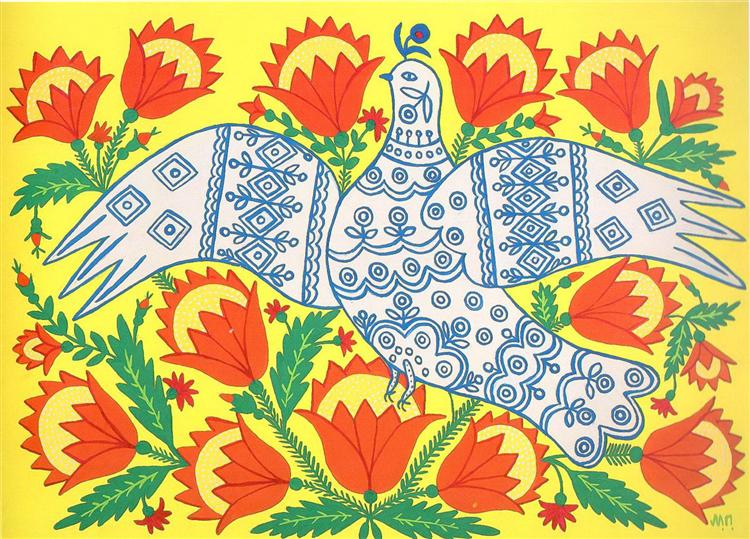“The most valuable possession you can own is an open heart. The most powerful weapon you can be is an instrument of peace.”
Carlos Santana
The image above; A Dove Has Spread Her Wings and Asks for Peace, is a work by self-taught Ukrainian artist Maria Prymachenko (1909-1997). After viewing an exhibition of her paintings at the World Exhibition in 1937 Paris, Picasso said, “I bow down before the artistic miracle of this brilliant Ukrainian.” Prymachenko used the distinct folk art designs of Ukraine in her work, known as Petrykivka painting, a type of storytelling with images and designs developed over centuries. She took these traditional elements with flattened two-dimensional planes and veered off, adding her own personal style, mixing dreams, myths, with surreal twists to the content. Prymachenko laid down thick self-assured lines of drawing creating her fantasy creature’s outlines in a single handstroke. Her heightened sense of color was another distinct standout of her art, a kind of joyful splash of psychedelic circus enters her paintings, widening definitions of the avant-garde school.
In the first days of Ukraine’s invasion, the Ivankiv Historical and Local History Museum, a small museum nortwest of Kyiv, that housed two dozen paintings of Maria Prymachenko was burned to the ground. Prymachenko was a peasant artist and avant-garde icon of Ukraine, where her fantastic primitive beasts and brightly colored designs represent peace and resistance. Her artwork is prized within Ukraine, and has been featured on postage stamps. An image of the artist was even reproduced on a Ukrainian silver coin. One consequence of this war is that Prymachenko’s wonders are now being shared and embraced around the world. Her art contains the indomitable spirit and soul of Ukraine, uniting the Ukranian people and reminding the world of the value of art to society.
As this was written, it was reported that the Holocaust Memorial of Babyn Yar in Kiev, a site where Nazi’s murdered over 30,000 Jews in two days, was also bombed. Kyiv is a city filled with small museums, and Artnet News described how they were scrambling to protect their art and culture; “As Ukraine defends itself against invading Russian forces, the nation’s museums find themselves in a dire situation, charged with protecting the nation’s art and culture in a time of crisis.”
The barbarity of destroying a country’s cultural heritage is from the playbook of Nazism, Apartheid, and ethnic cleansing. President Zelensky responded with the tweet, “To the world: what is the point of saying ‘never again’ for 80 years, if the world stays silent when a bomb drops on the same site of Babyn Yar? At least 5 killed. History repeating …” The Washington Post wrote,”Tuesday’s strike was the latest example of what human rights groups have described as indiscriminate attacks by Russian forces. Moscow has said it’s only targeting military infrastructure, but missiles and artillery shells have struck residential areas in Kyiv, Kharkiv and across Ukraine.The strike on the Holocaust memorial carried particular symbolic weight.”
Several Russian museums have stopped exhibitions in protest to the invasion, and Russian artists have pulled out of international exhibits.Over 17,000 Russian artists and art professionals across the country have signed a petition letter to end the war on Ukraine. This letter, which was published in Russian, partially read, “The war in Ukraine is a terrible tragedy for both Ukrainians and Russians. It brings great loss of human life, threatens our economy and security, and will lead our country to complete international isolation. At the same time, it is completely pointless — any enforcement of peace through violence is absurd. At this time we are primarily worried about the fate of Ukrainians — their lives and their safety.” In Russia even signing a petition is a dangerous act against the state. “Some of the petition’s signatories had already lost their jobs,” wrote the New York Times. One artist spoke out, “From my point of view, we have no future, so we have nothing to lose in speaking out against this, but at the same time we are all afraid.”
What is the role of art in a time of War? This was a question considered by Fragment gallery in New York, who are now prioritizing exhibitions by and about the Ukrainian people. “What is most prevalent through the arts is art’s role as a container for remembrance,” wrote Ayanna Dozier, “Memory is not passive and critical to the agency of a people. Art has not been and is currently not passive in this struggle….essentially, if art is the container for cultural memory, it is also what secures a future for a people and their community.”
President Zelensky, a genius at social media, stood infront of Kyiv’s Gorodetsky House, also known as the House with Chimeras, while he declared, “I am here. We are not laying down our arms. We will defend our state.” Created by the Polish architect Wladyslaw Horodeck in 1901-1902, who is considered the ‘Gaudi of Kyiv’, The House of Chimeras is a wildly creative building, that has symbolized the city. It made a beautiful and surreal backdrop of resistance for Zelensky, who has become a legendary force of imaginative thinking and creativity under the evil of oppression and unprovoked violence.

